Gun Violence, Mental Health, and US Gun Control: A Critical Analysis
VerifiedAdded on 2021/04/21
|30
|7753
|23
Report
AI Summary
This report investigates the complex relationship between gun violence, mental health, and gun control policies in the United States. It begins by addressing the ongoing debate surrounding mass shootings and the role of mental illness, exploring the public perception that links serious mental health issues to gun violence. The report examines the impact of gun control policies on mental health, arguing that the availability of guns without adequate safeguards has contributed to increased gun violence. A literature review is conducted, covering the background of mental health, gun violence, and post-traumatic stress syndrome. The report highlights key findings from studies on gun ownership, the impact of gun violence on children, and public attitudes towards gun control. It further analyzes the role of background checks, mental health considerations, and the need for stricter gun control laws to mitigate gun violence and its effects on mental health.
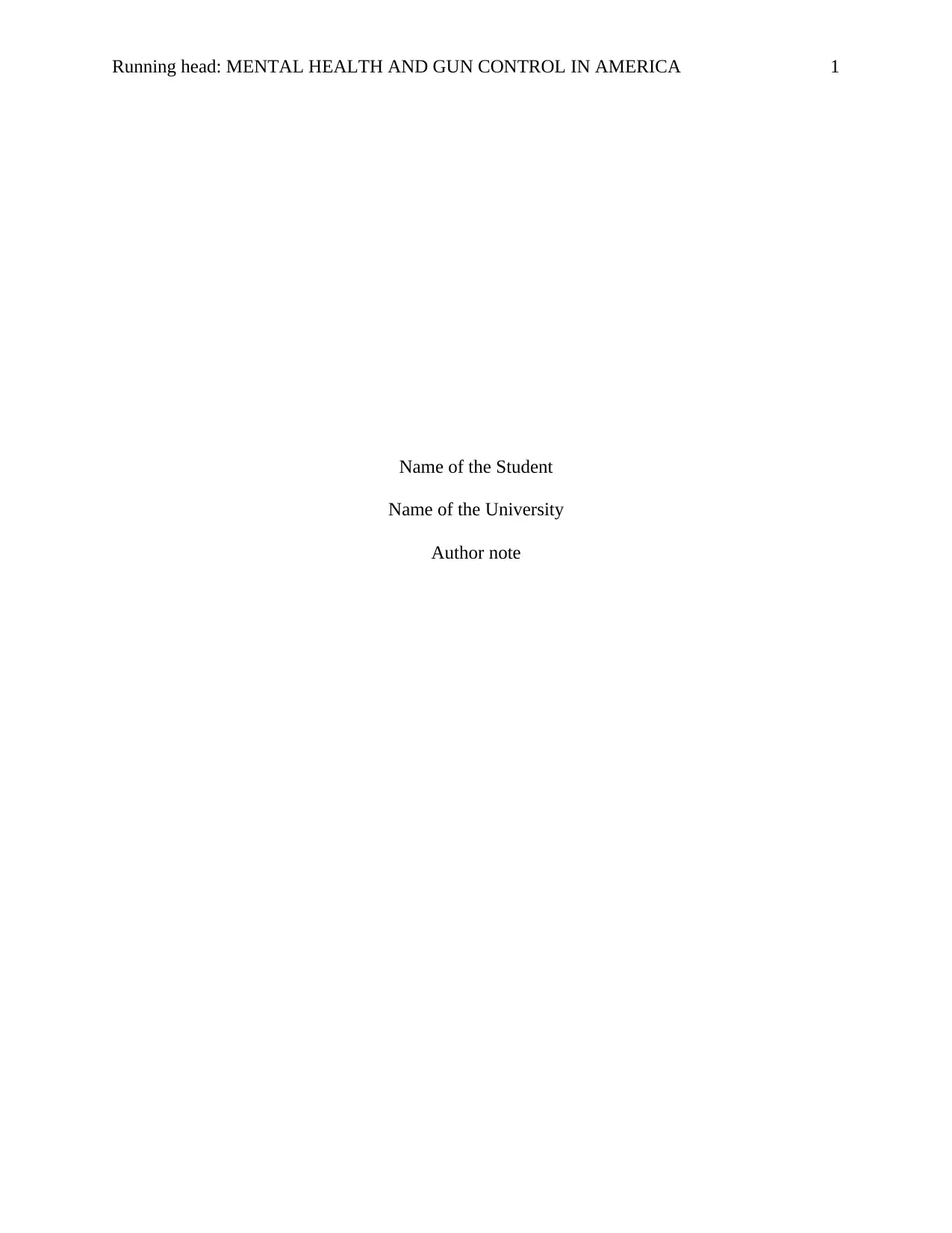
Running head: MENTAL HEALTH AND GUN CONTROL IN AMERICA 1
Name of the Student
Name of the University
Author note
Name of the Student
Name of the University
Author note
Paraphrase This Document
Need a fresh take? Get an instant paraphrase of this document with our AI Paraphraser
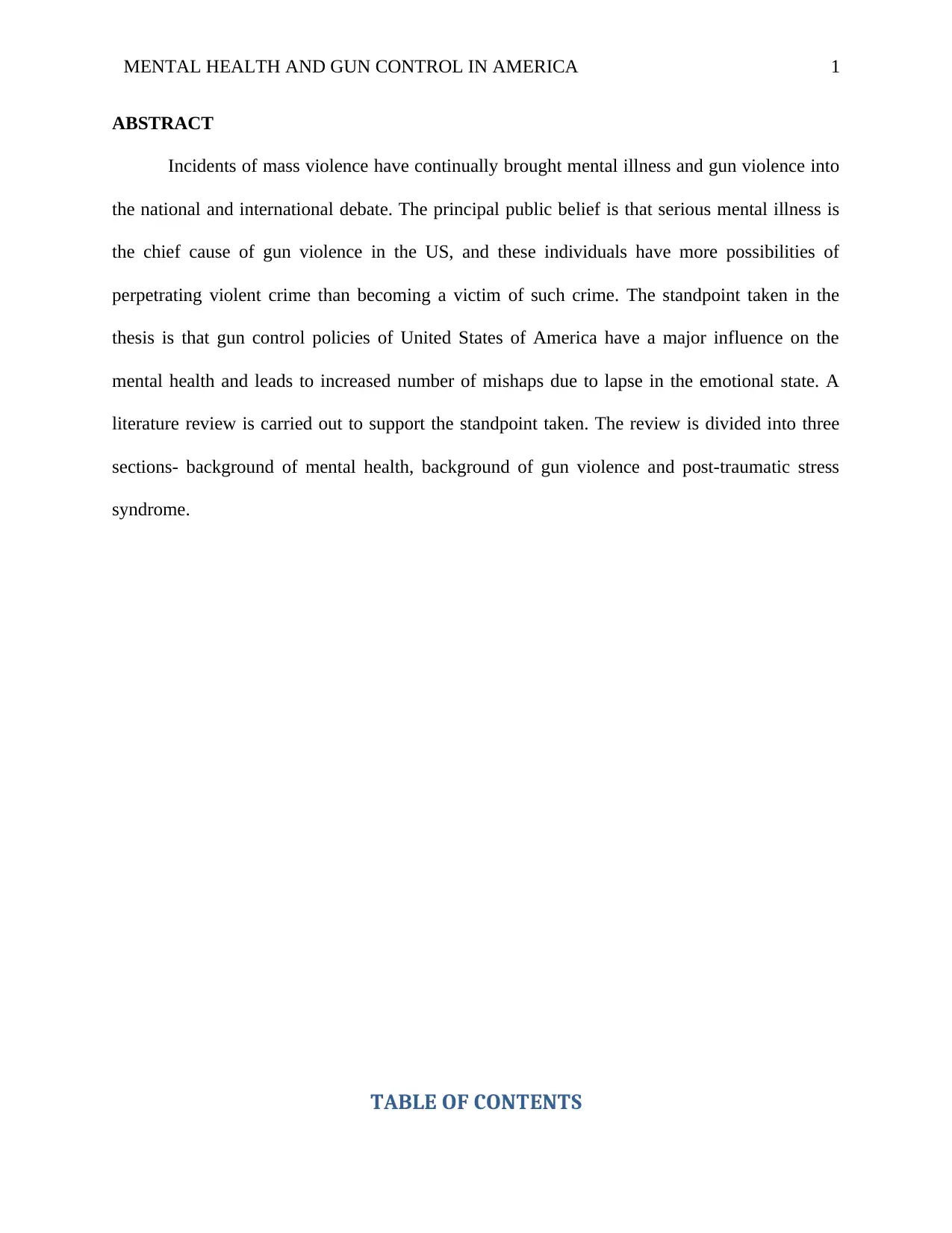
MENTAL HEALTH AND GUN CONTROL IN AMERICA 1
ABSTRACT
Incidents of mass violence have continually brought mental illness and gun violence into
the national and international debate. The principal public belief is that serious mental illness is
the chief cause of gun violence in the US, and these individuals have more possibilities of
perpetrating violent crime than becoming a victim of such crime. The standpoint taken in the
thesis is that gun control policies of United States of America have a major influence on the
mental health and leads to increased number of mishaps due to lapse in the emotional state. A
literature review is carried out to support the standpoint taken. The review is divided into three
sections- background of mental health, background of gun violence and post-traumatic stress
syndrome.
TABLE OF CONTENTS
ABSTRACT
Incidents of mass violence have continually brought mental illness and gun violence into
the national and international debate. The principal public belief is that serious mental illness is
the chief cause of gun violence in the US, and these individuals have more possibilities of
perpetrating violent crime than becoming a victim of such crime. The standpoint taken in the
thesis is that gun control policies of United States of America have a major influence on the
mental health and leads to increased number of mishaps due to lapse in the emotional state. A
literature review is carried out to support the standpoint taken. The review is divided into three
sections- background of mental health, background of gun violence and post-traumatic stress
syndrome.
TABLE OF CONTENTS
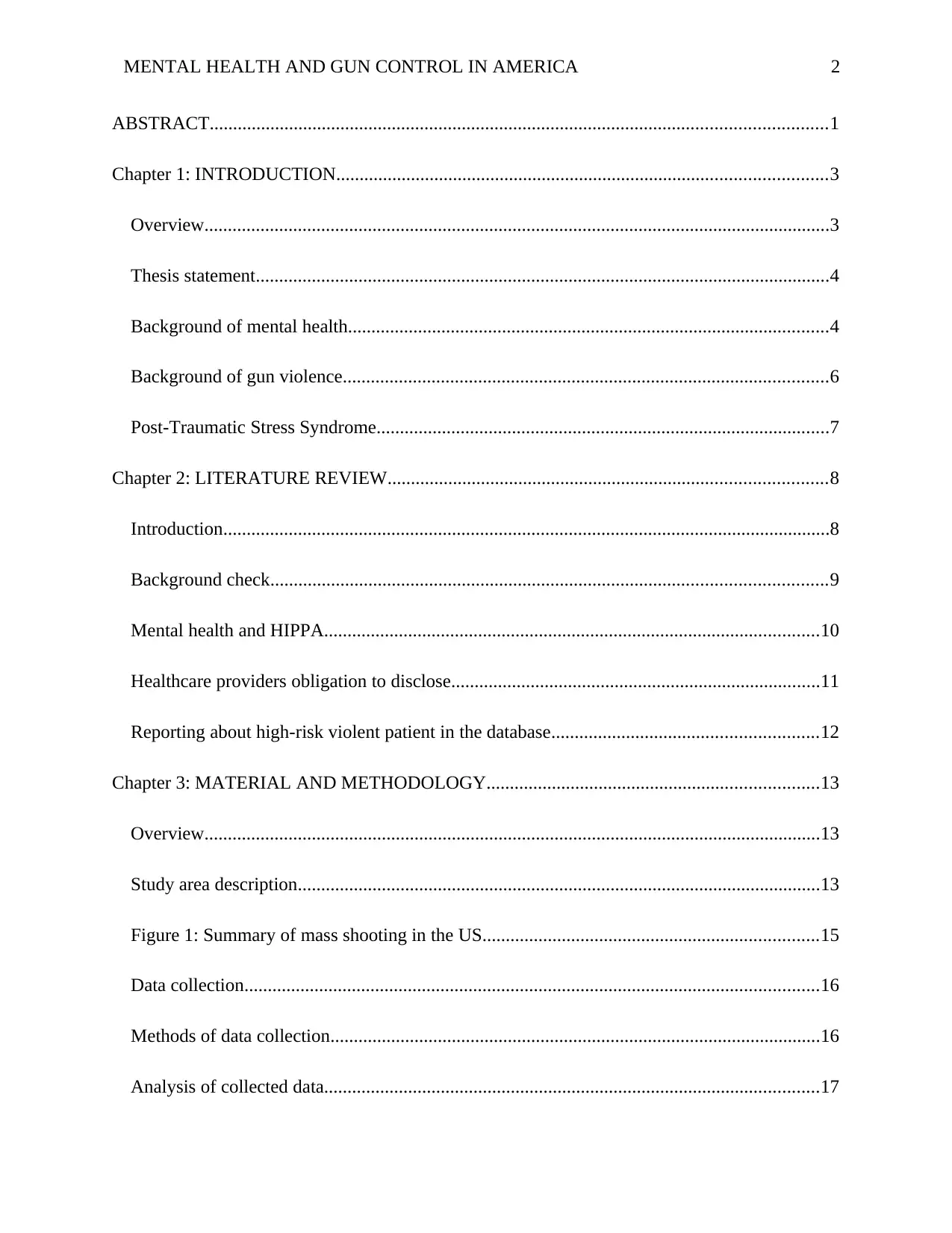
MENTAL HEALTH AND GUN CONTROL IN AMERICA 2
ABSTRACT....................................................................................................................................1
Chapter 1: INTRODUCTION.........................................................................................................3
Overview......................................................................................................................................3
Thesis statement...........................................................................................................................4
Background of mental health.......................................................................................................4
Background of gun violence........................................................................................................6
Post-Traumatic Stress Syndrome.................................................................................................7
Chapter 2: LITERATURE REVIEW..............................................................................................8
Introduction..................................................................................................................................8
Background check.......................................................................................................................9
Mental health and HIPPA..........................................................................................................10
Healthcare providers obligation to disclose...............................................................................11
Reporting about high-risk violent patient in the database.........................................................12
Chapter 3: MATERIAL AND METHODOLOGY.......................................................................13
Overview....................................................................................................................................13
Study area description................................................................................................................13
Figure 1: Summary of mass shooting in the US........................................................................15
Data collection...........................................................................................................................16
Methods of data collection.........................................................................................................16
Analysis of collected data..........................................................................................................17
ABSTRACT....................................................................................................................................1
Chapter 1: INTRODUCTION.........................................................................................................3
Overview......................................................................................................................................3
Thesis statement...........................................................................................................................4
Background of mental health.......................................................................................................4
Background of gun violence........................................................................................................6
Post-Traumatic Stress Syndrome.................................................................................................7
Chapter 2: LITERATURE REVIEW..............................................................................................8
Introduction..................................................................................................................................8
Background check.......................................................................................................................9
Mental health and HIPPA..........................................................................................................10
Healthcare providers obligation to disclose...............................................................................11
Reporting about high-risk violent patient in the database.........................................................12
Chapter 3: MATERIAL AND METHODOLOGY.......................................................................13
Overview....................................................................................................................................13
Study area description................................................................................................................13
Figure 1: Summary of mass shooting in the US........................................................................15
Data collection...........................................................................................................................16
Methods of data collection.........................................................................................................16
Analysis of collected data..........................................................................................................17
⊘ This is a preview!⊘
Do you want full access?
Subscribe today to unlock all pages.

Trusted by 1+ million students worldwide
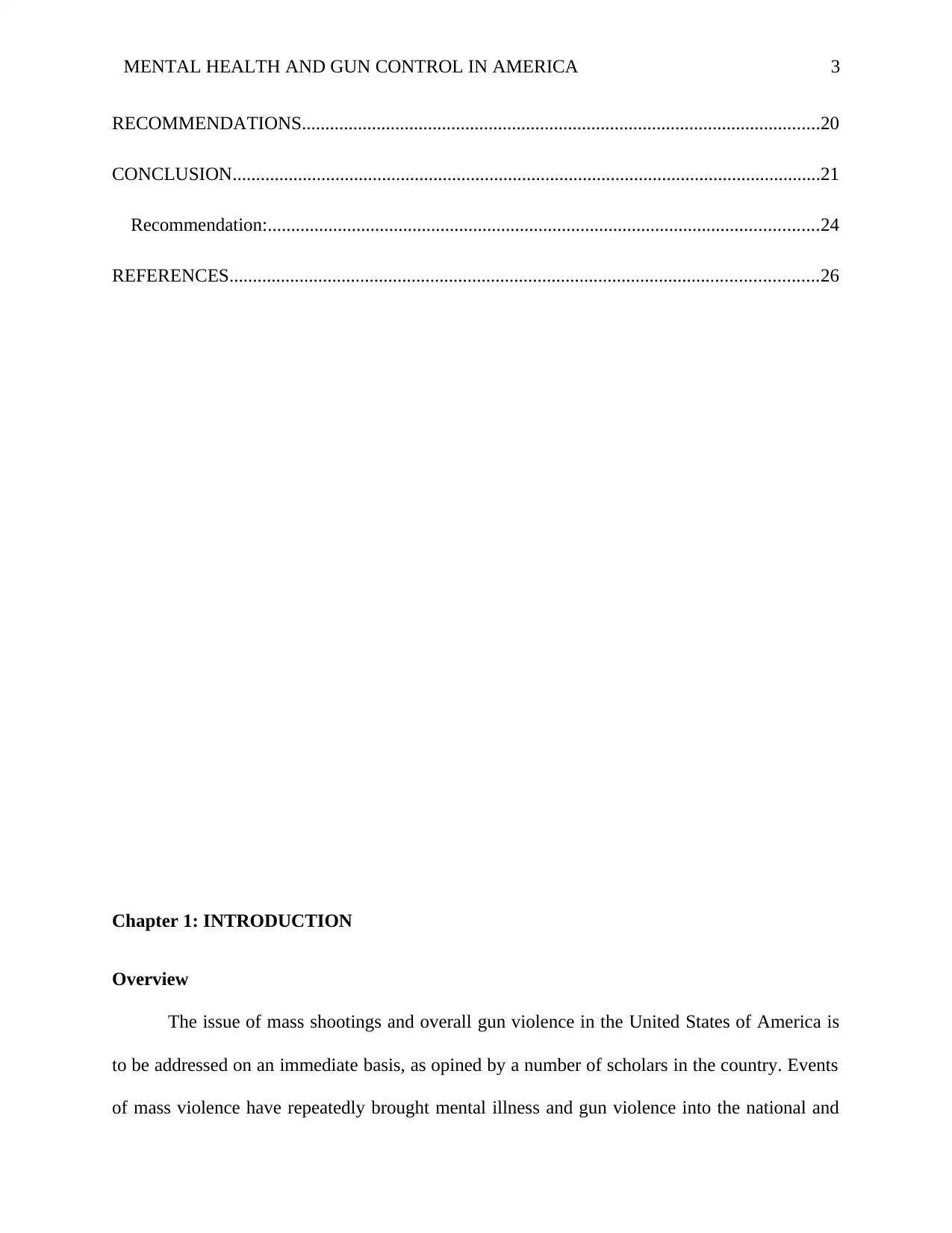
MENTAL HEALTH AND GUN CONTROL IN AMERICA 3
RECOMMENDATIONS...............................................................................................................20
CONCLUSION..............................................................................................................................21
Recommendation:......................................................................................................................24
REFERENCES..............................................................................................................................26
Chapter 1: INTRODUCTION
Overview
The issue of mass shootings and overall gun violence in the United States of America is
to be addressed on an immediate basis, as opined by a number of scholars in the country. Events
of mass violence have repeatedly brought mental illness and gun violence into the national and
RECOMMENDATIONS...............................................................................................................20
CONCLUSION..............................................................................................................................21
Recommendation:......................................................................................................................24
REFERENCES..............................................................................................................................26
Chapter 1: INTRODUCTION
Overview
The issue of mass shootings and overall gun violence in the United States of America is
to be addressed on an immediate basis, as opined by a number of scholars in the country. Events
of mass violence have repeatedly brought mental illness and gun violence into the national and
Paraphrase This Document
Need a fresh take? Get an instant paraphrase of this document with our AI Paraphraser
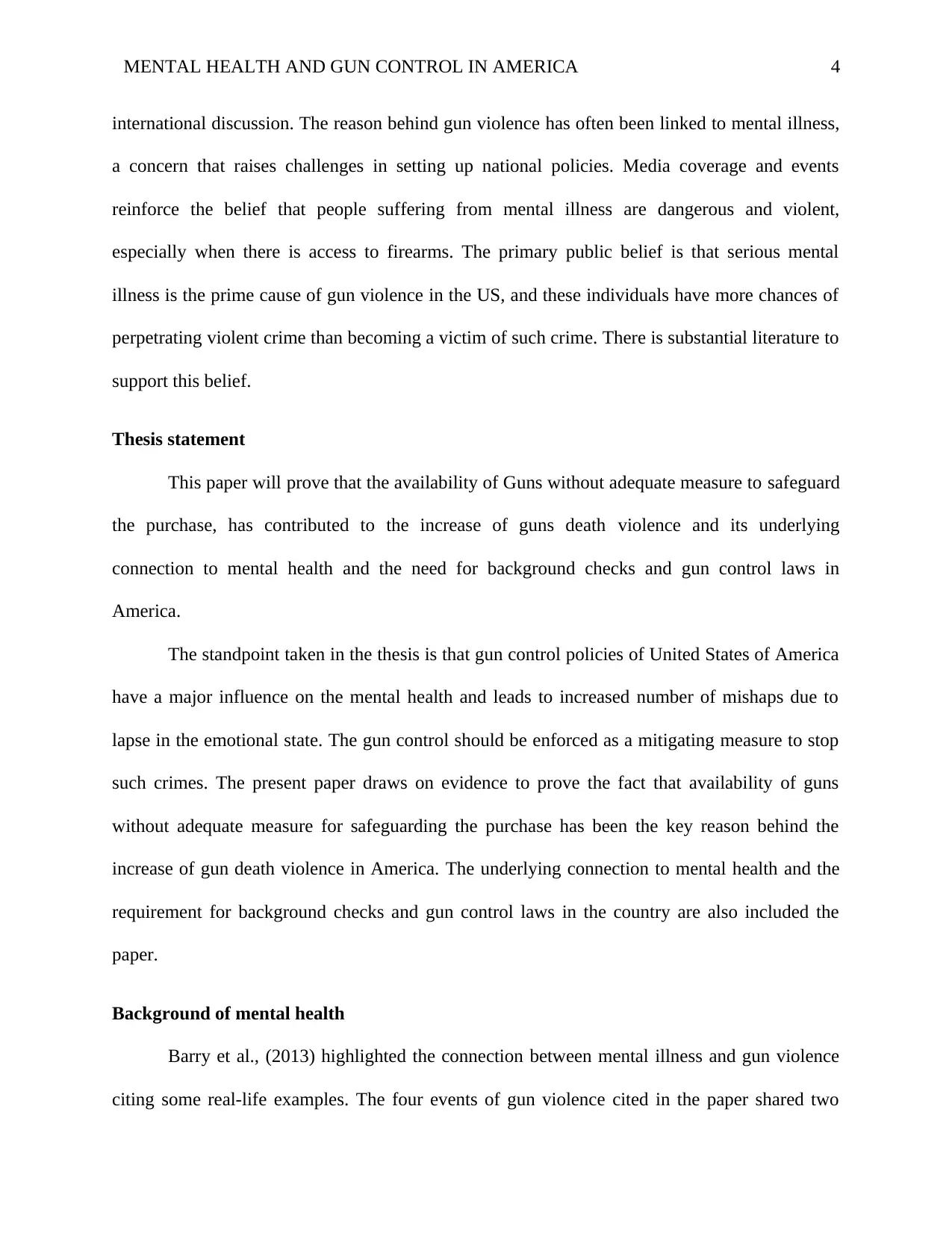
MENTAL HEALTH AND GUN CONTROL IN AMERICA 4
international discussion. The reason behind gun violence has often been linked to mental illness,
a concern that raises challenges in setting up national policies. Media coverage and events
reinforce the belief that people suffering from mental illness are dangerous and violent,
especially when there is access to firearms. The primary public belief is that serious mental
illness is the prime cause of gun violence in the US, and these individuals have more chances of
perpetrating violent crime than becoming a victim of such crime. There is substantial literature to
support this belief.
Thesis statement
This paper will prove that the availability of Guns without adequate measure to safeguard
the purchase, has contributed to the increase of guns death violence and its underlying
connection to mental health and the need for background checks and gun control laws in
America.
The standpoint taken in the thesis is that gun control policies of United States of America
have a major influence on the mental health and leads to increased number of mishaps due to
lapse in the emotional state. The gun control should be enforced as a mitigating measure to stop
such crimes. The present paper draws on evidence to prove the fact that availability of guns
without adequate measure for safeguarding the purchase has been the key reason behind the
increase of gun death violence in America. The underlying connection to mental health and the
requirement for background checks and gun control laws in the country are also included the
paper.
Background of mental health
Barry et al., (2013) highlighted the connection between mental illness and gun violence
citing some real-life examples. The four events of gun violence cited in the paper shared two
international discussion. The reason behind gun violence has often been linked to mental illness,
a concern that raises challenges in setting up national policies. Media coverage and events
reinforce the belief that people suffering from mental illness are dangerous and violent,
especially when there is access to firearms. The primary public belief is that serious mental
illness is the prime cause of gun violence in the US, and these individuals have more chances of
perpetrating violent crime than becoming a victim of such crime. There is substantial literature to
support this belief.
Thesis statement
This paper will prove that the availability of Guns without adequate measure to safeguard
the purchase, has contributed to the increase of guns death violence and its underlying
connection to mental health and the need for background checks and gun control laws in
America.
The standpoint taken in the thesis is that gun control policies of United States of America
have a major influence on the mental health and leads to increased number of mishaps due to
lapse in the emotional state. The gun control should be enforced as a mitigating measure to stop
such crimes. The present paper draws on evidence to prove the fact that availability of guns
without adequate measure for safeguarding the purchase has been the key reason behind the
increase of gun death violence in America. The underlying connection to mental health and the
requirement for background checks and gun control laws in the country are also included the
paper.
Background of mental health
Barry et al., (2013) highlighted the connection between mental illness and gun violence
citing some real-life examples. The four events of gun violence cited in the paper shared two
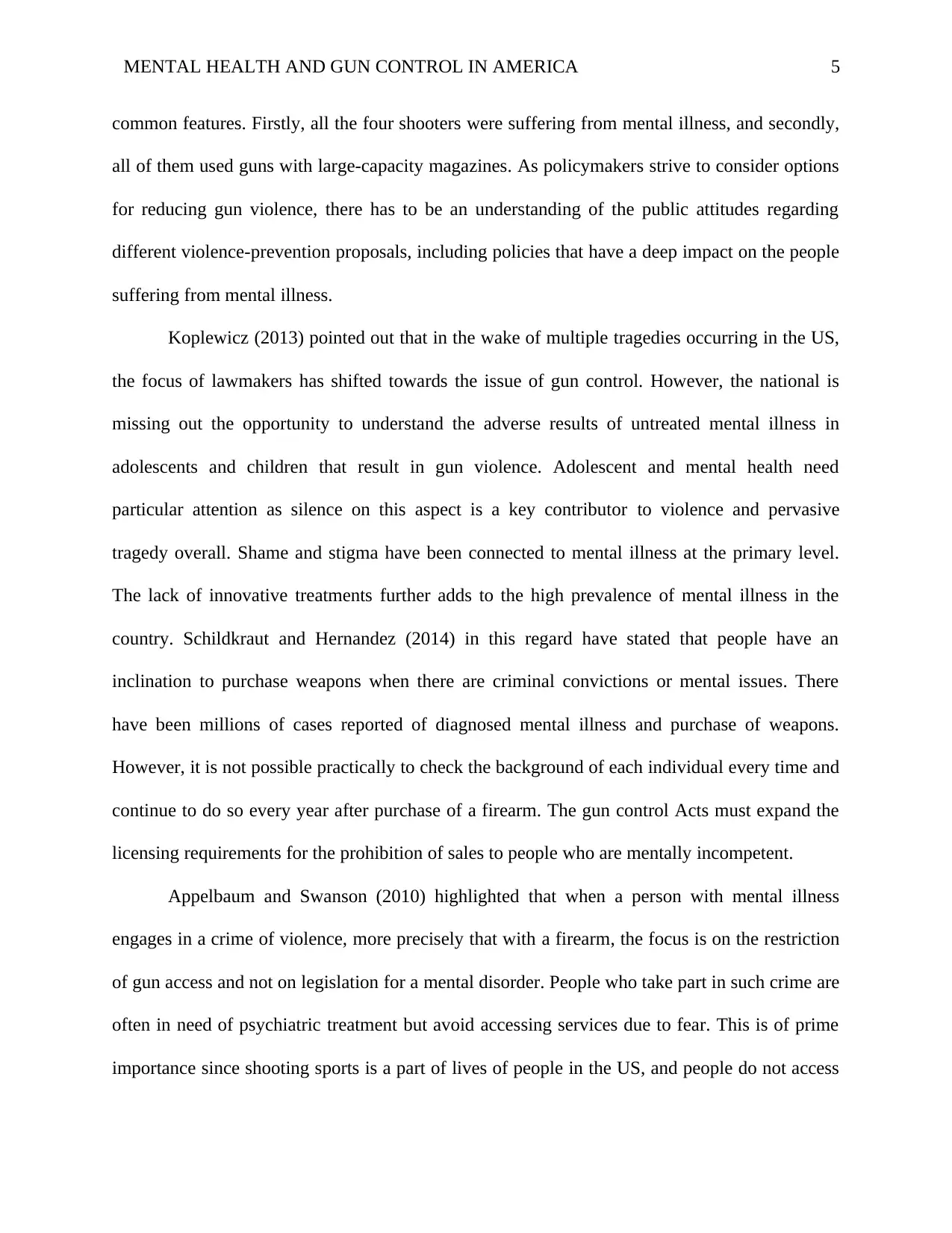
MENTAL HEALTH AND GUN CONTROL IN AMERICA 5
common features. Firstly, all the four shooters were suffering from mental illness, and secondly,
all of them used guns with large-capacity magazines. As policymakers strive to consider options
for reducing gun violence, there has to be an understanding of the public attitudes regarding
different violence-prevention proposals, including policies that have a deep impact on the people
suffering from mental illness.
Koplewicz (2013) pointed out that in the wake of multiple tragedies occurring in the US,
the focus of lawmakers has shifted towards the issue of gun control. However, the national is
missing out the opportunity to understand the adverse results of untreated mental illness in
adolescents and children that result in gun violence. Adolescent and mental health need
particular attention as silence on this aspect is a key contributor to violence and pervasive
tragedy overall. Shame and stigma have been connected to mental illness at the primary level.
The lack of innovative treatments further adds to the high prevalence of mental illness in the
country. Schildkraut and Hernandez (2014) in this regard have stated that people have an
inclination to purchase weapons when there are criminal convictions or mental issues. There
have been millions of cases reported of diagnosed mental illness and purchase of weapons.
However, it is not possible practically to check the background of each individual every time and
continue to do so every year after purchase of a firearm. The gun control Acts must expand the
licensing requirements for the prohibition of sales to people who are mentally incompetent.
Appelbaum and Swanson (2010) highlighted that when a person with mental illness
engages in a crime of violence, more precisely that with a firearm, the focus is on the restriction
of gun access and not on legislation for a mental disorder. People who take part in such crime are
often in need of psychiatric treatment but avoid accessing services due to fear. This is of prime
importance since shooting sports is a part of lives of people in the US, and people do not access
common features. Firstly, all the four shooters were suffering from mental illness, and secondly,
all of them used guns with large-capacity magazines. As policymakers strive to consider options
for reducing gun violence, there has to be an understanding of the public attitudes regarding
different violence-prevention proposals, including policies that have a deep impact on the people
suffering from mental illness.
Koplewicz (2013) pointed out that in the wake of multiple tragedies occurring in the US,
the focus of lawmakers has shifted towards the issue of gun control. However, the national is
missing out the opportunity to understand the adverse results of untreated mental illness in
adolescents and children that result in gun violence. Adolescent and mental health need
particular attention as silence on this aspect is a key contributor to violence and pervasive
tragedy overall. Shame and stigma have been connected to mental illness at the primary level.
The lack of innovative treatments further adds to the high prevalence of mental illness in the
country. Schildkraut and Hernandez (2014) in this regard have stated that people have an
inclination to purchase weapons when there are criminal convictions or mental issues. There
have been millions of cases reported of diagnosed mental illness and purchase of weapons.
However, it is not possible practically to check the background of each individual every time and
continue to do so every year after purchase of a firearm. The gun control Acts must expand the
licensing requirements for the prohibition of sales to people who are mentally incompetent.
Appelbaum and Swanson (2010) highlighted that when a person with mental illness
engages in a crime of violence, more precisely that with a firearm, the focus is on the restriction
of gun access and not on legislation for a mental disorder. People who take part in such crime are
often in need of psychiatric treatment but avoid accessing services due to fear. This is of prime
importance since shooting sports is a part of lives of people in the US, and people do not access
⊘ This is a preview!⊘
Do you want full access?
Subscribe today to unlock all pages.

Trusted by 1+ million students worldwide
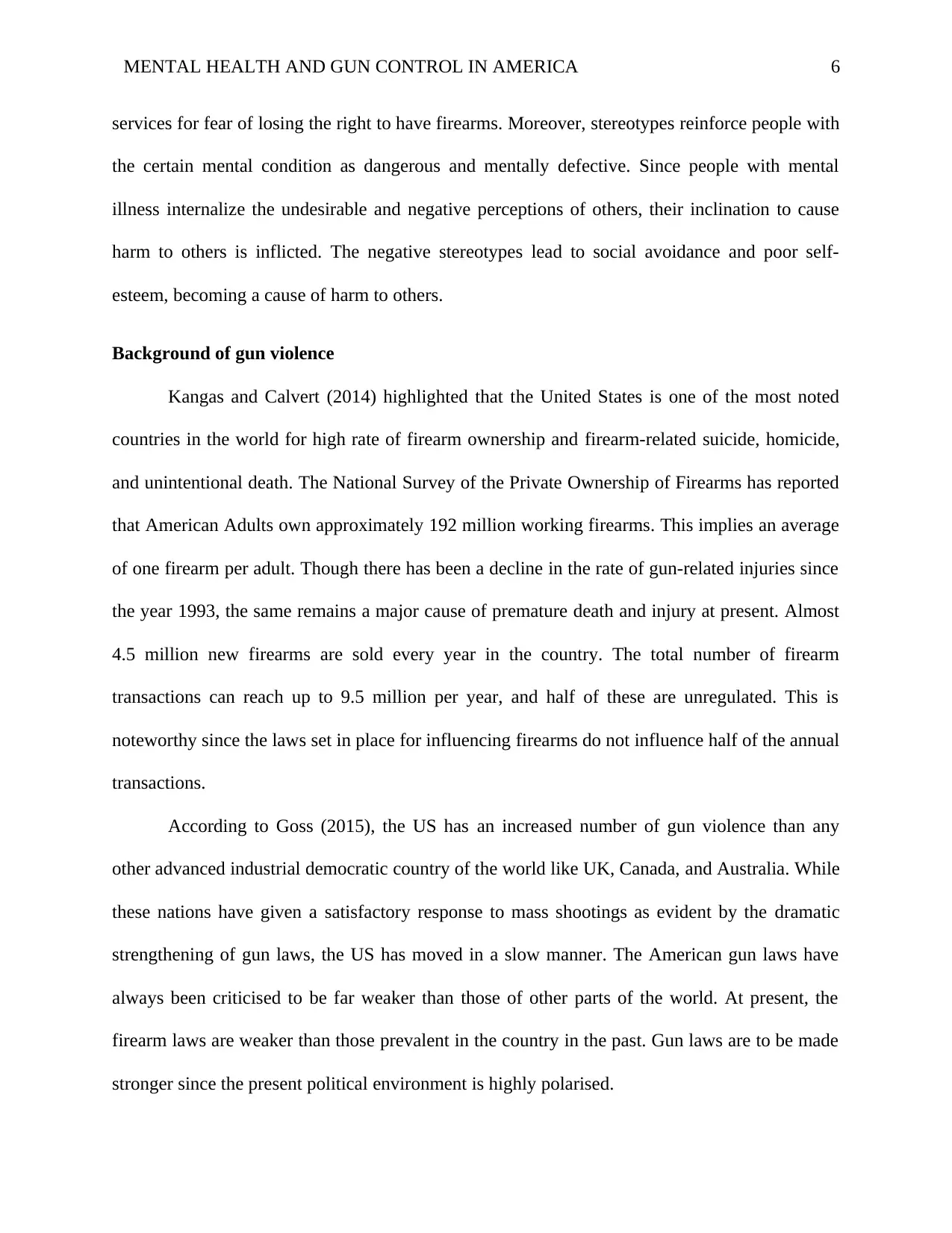
MENTAL HEALTH AND GUN CONTROL IN AMERICA 6
services for fear of losing the right to have firearms. Moreover, stereotypes reinforce people with
the certain mental condition as dangerous and mentally defective. Since people with mental
illness internalize the undesirable and negative perceptions of others, their inclination to cause
harm to others is inflicted. The negative stereotypes lead to social avoidance and poor self-
esteem, becoming a cause of harm to others.
Background of gun violence
Kangas and Calvert (2014) highlighted that the United States is one of the most noted
countries in the world for high rate of firearm ownership and firearm-related suicide, homicide,
and unintentional death. The National Survey of the Private Ownership of Firearms has reported
that American Adults own approximately 192 million working firearms. This implies an average
of one firearm per adult. Though there has been a decline in the rate of gun-related injuries since
the year 1993, the same remains a major cause of premature death and injury at present. Almost
4.5 million new firearms are sold every year in the country. The total number of firearm
transactions can reach up to 9.5 million per year, and half of these are unregulated. This is
noteworthy since the laws set in place for influencing firearms do not influence half of the annual
transactions.
According to Goss (2015), the US has an increased number of gun violence than any
other advanced industrial democratic country of the world like UK, Canada, and Australia. While
these nations have given a satisfactory response to mass shootings as evident by the dramatic
strengthening of gun laws, the US has moved in a slow manner. The American gun laws have
always been criticised to be far weaker than those of other parts of the world. At present, the
firearm laws are weaker than those prevalent in the country in the past. Gun laws are to be made
stronger since the present political environment is highly polarised.
services for fear of losing the right to have firearms. Moreover, stereotypes reinforce people with
the certain mental condition as dangerous and mentally defective. Since people with mental
illness internalize the undesirable and negative perceptions of others, their inclination to cause
harm to others is inflicted. The negative stereotypes lead to social avoidance and poor self-
esteem, becoming a cause of harm to others.
Background of gun violence
Kangas and Calvert (2014) highlighted that the United States is one of the most noted
countries in the world for high rate of firearm ownership and firearm-related suicide, homicide,
and unintentional death. The National Survey of the Private Ownership of Firearms has reported
that American Adults own approximately 192 million working firearms. This implies an average
of one firearm per adult. Though there has been a decline in the rate of gun-related injuries since
the year 1993, the same remains a major cause of premature death and injury at present. Almost
4.5 million new firearms are sold every year in the country. The total number of firearm
transactions can reach up to 9.5 million per year, and half of these are unregulated. This is
noteworthy since the laws set in place for influencing firearms do not influence half of the annual
transactions.
According to Goss (2015), the US has an increased number of gun violence than any
other advanced industrial democratic country of the world like UK, Canada, and Australia. While
these nations have given a satisfactory response to mass shootings as evident by the dramatic
strengthening of gun laws, the US has moved in a slow manner. The American gun laws have
always been criticised to be far weaker than those of other parts of the world. At present, the
firearm laws are weaker than those prevalent in the country in the past. Gun laws are to be made
stronger since the present political environment is highly polarised.
Paraphrase This Document
Need a fresh take? Get an instant paraphrase of this document with our AI Paraphraser
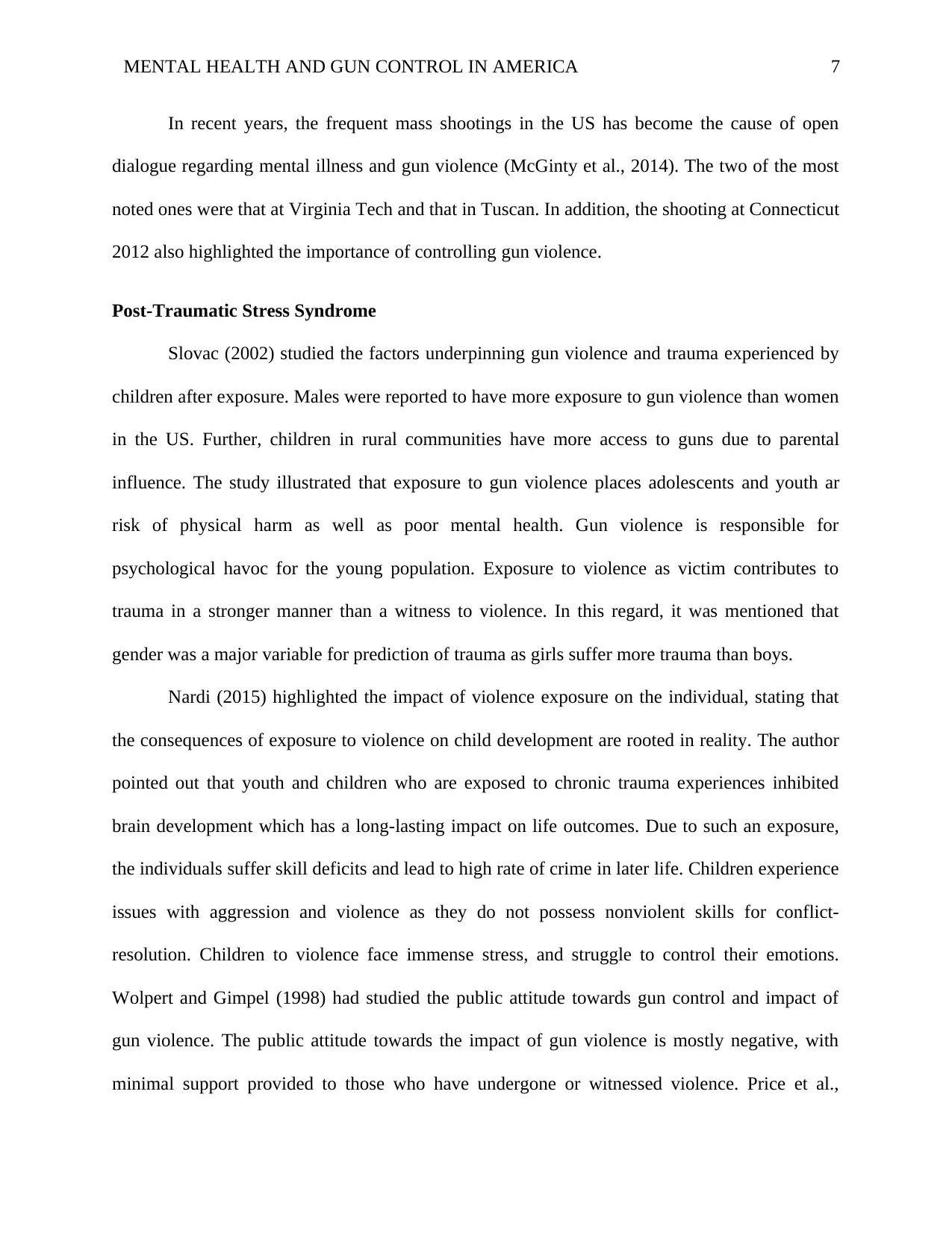
MENTAL HEALTH AND GUN CONTROL IN AMERICA 7
In recent years, the frequent mass shootings in the US has become the cause of open
dialogue regarding mental illness and gun violence (McGinty et al., 2014). The two of the most
noted ones were that at Virginia Tech and that in Tuscan. In addition, the shooting at Connecticut
2012 also highlighted the importance of controlling gun violence.
Post-Traumatic Stress Syndrome
Slovac (2002) studied the factors underpinning gun violence and trauma experienced by
children after exposure. Males were reported to have more exposure to gun violence than women
in the US. Further, children in rural communities have more access to guns due to parental
influence. The study illustrated that exposure to gun violence places adolescents and youth ar
risk of physical harm as well as poor mental health. Gun violence is responsible for
psychological havoc for the young population. Exposure to violence as victim contributes to
trauma in a stronger manner than a witness to violence. In this regard, it was mentioned that
gender was a major variable for prediction of trauma as girls suffer more trauma than boys.
Nardi (2015) highlighted the impact of violence exposure on the individual, stating that
the consequences of exposure to violence on child development are rooted in reality. The author
pointed out that youth and children who are exposed to chronic trauma experiences inhibited
brain development which has a long-lasting impact on life outcomes. Due to such an exposure,
the individuals suffer skill deficits and lead to high rate of crime in later life. Children experience
issues with aggression and violence as they do not possess nonviolent skills for conflict-
resolution. Children to violence face immense stress, and struggle to control their emotions.
Wolpert and Gimpel (1998) had studied the public attitude towards gun control and impact of
gun violence. The public attitude towards the impact of gun violence is mostly negative, with
minimal support provided to those who have undergone or witnessed violence. Price et al.,
In recent years, the frequent mass shootings in the US has become the cause of open
dialogue regarding mental illness and gun violence (McGinty et al., 2014). The two of the most
noted ones were that at Virginia Tech and that in Tuscan. In addition, the shooting at Connecticut
2012 also highlighted the importance of controlling gun violence.
Post-Traumatic Stress Syndrome
Slovac (2002) studied the factors underpinning gun violence and trauma experienced by
children after exposure. Males were reported to have more exposure to gun violence than women
in the US. Further, children in rural communities have more access to guns due to parental
influence. The study illustrated that exposure to gun violence places adolescents and youth ar
risk of physical harm as well as poor mental health. Gun violence is responsible for
psychological havoc for the young population. Exposure to violence as victim contributes to
trauma in a stronger manner than a witness to violence. In this regard, it was mentioned that
gender was a major variable for prediction of trauma as girls suffer more trauma than boys.
Nardi (2015) highlighted the impact of violence exposure on the individual, stating that
the consequences of exposure to violence on child development are rooted in reality. The author
pointed out that youth and children who are exposed to chronic trauma experiences inhibited
brain development which has a long-lasting impact on life outcomes. Due to such an exposure,
the individuals suffer skill deficits and lead to high rate of crime in later life. Children experience
issues with aggression and violence as they do not possess nonviolent skills for conflict-
resolution. Children to violence face immense stress, and struggle to control their emotions.
Wolpert and Gimpel (1998) had studied the public attitude towards gun control and impact of
gun violence. The public attitude towards the impact of gun violence is mostly negative, with
minimal support provided to those who have undergone or witnessed violence. Price et al.,
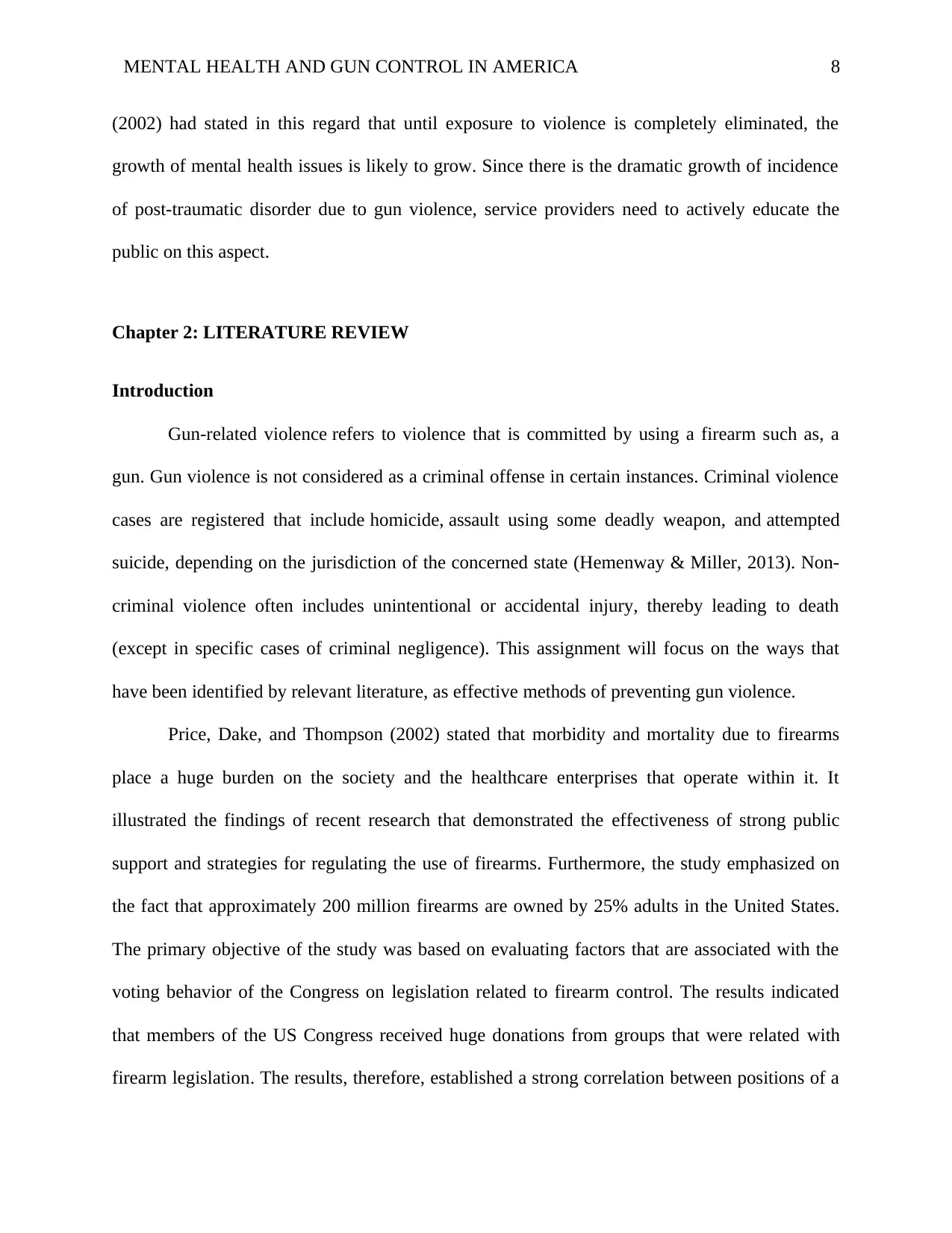
MENTAL HEALTH AND GUN CONTROL IN AMERICA 8
(2002) had stated in this regard that until exposure to violence is completely eliminated, the
growth of mental health issues is likely to grow. Since there is the dramatic growth of incidence
of post-traumatic disorder due to gun violence, service providers need to actively educate the
public on this aspect.
Chapter 2: LITERATURE REVIEW
Introduction
Gun-related violence refers to violence that is committed by using a firearm such as, a
gun. Gun violence is not considered as a criminal offense in certain instances. Criminal violence
cases are registered that include homicide, assault using some deadly weapon, and attempted
suicide, depending on the jurisdiction of the concerned state (Hemenway & Miller, 2013). Non-
criminal violence often includes unintentional or accidental injury, thereby leading to death
(except in specific cases of criminal negligence). This assignment will focus on the ways that
have been identified by relevant literature, as effective methods of preventing gun violence.
Price, Dake, and Thompson (2002) stated that morbidity and mortality due to firearms
place a huge burden on the society and the healthcare enterprises that operate within it. It
illustrated the findings of recent research that demonstrated the effectiveness of strong public
support and strategies for regulating the use of firearms. Furthermore, the study emphasized on
the fact that approximately 200 million firearms are owned by 25% adults in the United States.
The primary objective of the study was based on evaluating factors that are associated with the
voting behavior of the Congress on legislation related to firearm control. The results indicated
that members of the US Congress received huge donations from groups that were related with
firearm legislation. The results, therefore, established a strong correlation between positions of a
(2002) had stated in this regard that until exposure to violence is completely eliminated, the
growth of mental health issues is likely to grow. Since there is the dramatic growth of incidence
of post-traumatic disorder due to gun violence, service providers need to actively educate the
public on this aspect.
Chapter 2: LITERATURE REVIEW
Introduction
Gun-related violence refers to violence that is committed by using a firearm such as, a
gun. Gun violence is not considered as a criminal offense in certain instances. Criminal violence
cases are registered that include homicide, assault using some deadly weapon, and attempted
suicide, depending on the jurisdiction of the concerned state (Hemenway & Miller, 2013). Non-
criminal violence often includes unintentional or accidental injury, thereby leading to death
(except in specific cases of criminal negligence). This assignment will focus on the ways that
have been identified by relevant literature, as effective methods of preventing gun violence.
Price, Dake, and Thompson (2002) stated that morbidity and mortality due to firearms
place a huge burden on the society and the healthcare enterprises that operate within it. It
illustrated the findings of recent research that demonstrated the effectiveness of strong public
support and strategies for regulating the use of firearms. Furthermore, the study emphasized on
the fact that approximately 200 million firearms are owned by 25% adults in the United States.
The primary objective of the study was based on evaluating factors that are associated with the
voting behavior of the Congress on legislation related to firearm control. The results indicated
that members of the US Congress received huge donations from groups that were related with
firearm legislation. The results, therefore, established a strong correlation between positions of a
⊘ This is a preview!⊘
Do you want full access?
Subscribe today to unlock all pages.

Trusted by 1+ million students worldwide
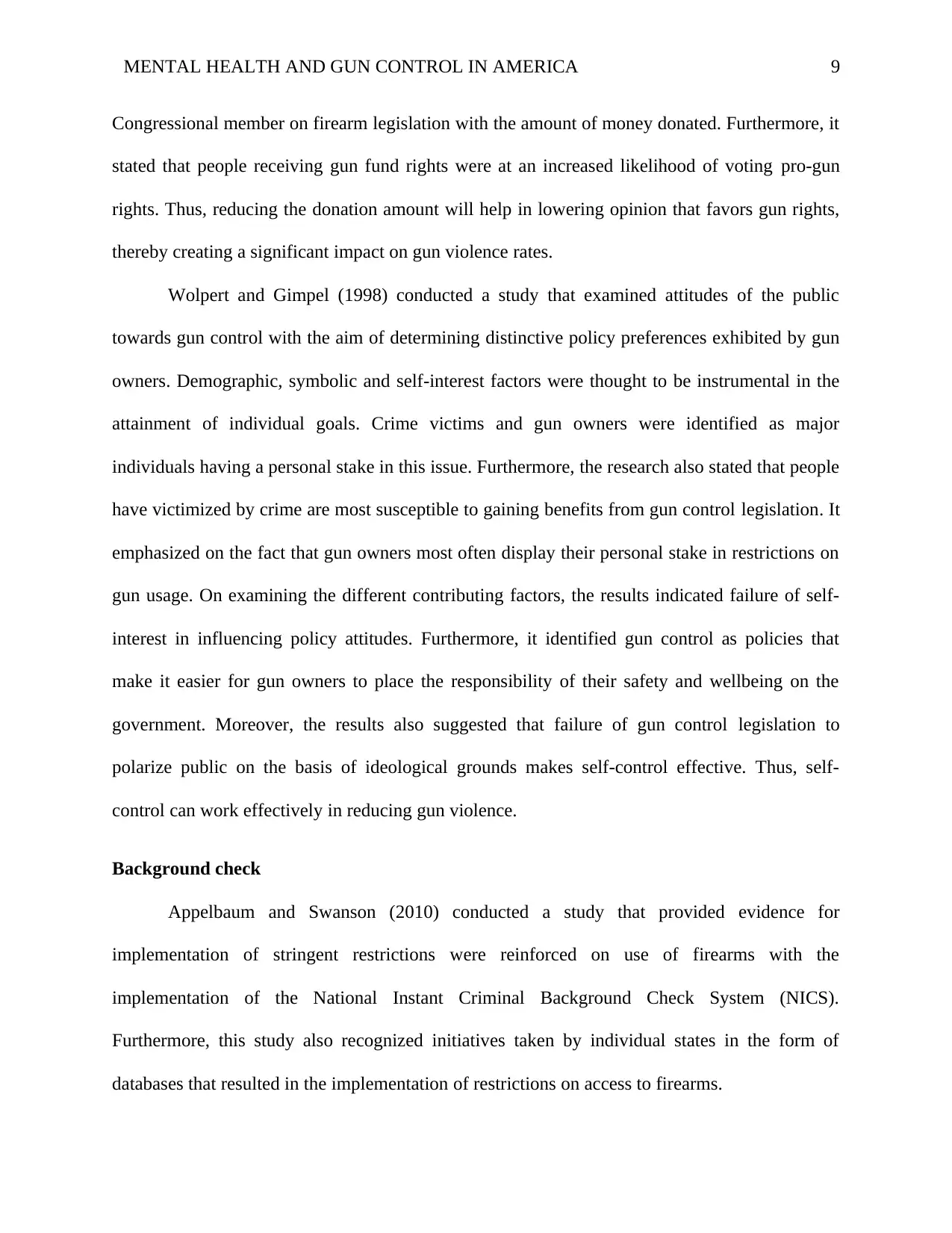
MENTAL HEALTH AND GUN CONTROL IN AMERICA 9
Congressional member on firearm legislation with the amount of money donated. Furthermore, it
stated that people receiving gun fund rights were at an increased likelihood of voting pro-gun
rights. Thus, reducing the donation amount will help in lowering opinion that favors gun rights,
thereby creating a significant impact on gun violence rates.
Wolpert and Gimpel (1998) conducted a study that examined attitudes of the public
towards gun control with the aim of determining distinctive policy preferences exhibited by gun
owners. Demographic, symbolic and self-interest factors were thought to be instrumental in the
attainment of individual goals. Crime victims and gun owners were identified as major
individuals having a personal stake in this issue. Furthermore, the research also stated that people
have victimized by crime are most susceptible to gaining benefits from gun control legislation. It
emphasized on the fact that gun owners most often display their personal stake in restrictions on
gun usage. On examining the different contributing factors, the results indicated failure of self-
interest in influencing policy attitudes. Furthermore, it identified gun control as policies that
make it easier for gun owners to place the responsibility of their safety and wellbeing on the
government. Moreover, the results also suggested that failure of gun control legislation to
polarize public on the basis of ideological grounds makes self-control effective. Thus, self-
control can work effectively in reducing gun violence.
Background check
Appelbaum and Swanson (2010) conducted a study that provided evidence for
implementation of stringent restrictions were reinforced on use of firearms with the
implementation of the National Instant Criminal Background Check System (NICS).
Furthermore, this study also recognized initiatives taken by individual states in the form of
databases that resulted in the implementation of restrictions on access to firearms.
Congressional member on firearm legislation with the amount of money donated. Furthermore, it
stated that people receiving gun fund rights were at an increased likelihood of voting pro-gun
rights. Thus, reducing the donation amount will help in lowering opinion that favors gun rights,
thereby creating a significant impact on gun violence rates.
Wolpert and Gimpel (1998) conducted a study that examined attitudes of the public
towards gun control with the aim of determining distinctive policy preferences exhibited by gun
owners. Demographic, symbolic and self-interest factors were thought to be instrumental in the
attainment of individual goals. Crime victims and gun owners were identified as major
individuals having a personal stake in this issue. Furthermore, the research also stated that people
have victimized by crime are most susceptible to gaining benefits from gun control legislation. It
emphasized on the fact that gun owners most often display their personal stake in restrictions on
gun usage. On examining the different contributing factors, the results indicated failure of self-
interest in influencing policy attitudes. Furthermore, it identified gun control as policies that
make it easier for gun owners to place the responsibility of their safety and wellbeing on the
government. Moreover, the results also suggested that failure of gun control legislation to
polarize public on the basis of ideological grounds makes self-control effective. Thus, self-
control can work effectively in reducing gun violence.
Background check
Appelbaum and Swanson (2010) conducted a study that provided evidence for
implementation of stringent restrictions were reinforced on use of firearms with the
implementation of the National Instant Criminal Background Check System (NICS).
Furthermore, this study also recognized initiatives taken by individual states in the form of
databases that resulted in the implementation of restrictions on access to firearms.
Paraphrase This Document
Need a fresh take? Get an instant paraphrase of this document with our AI Paraphraser
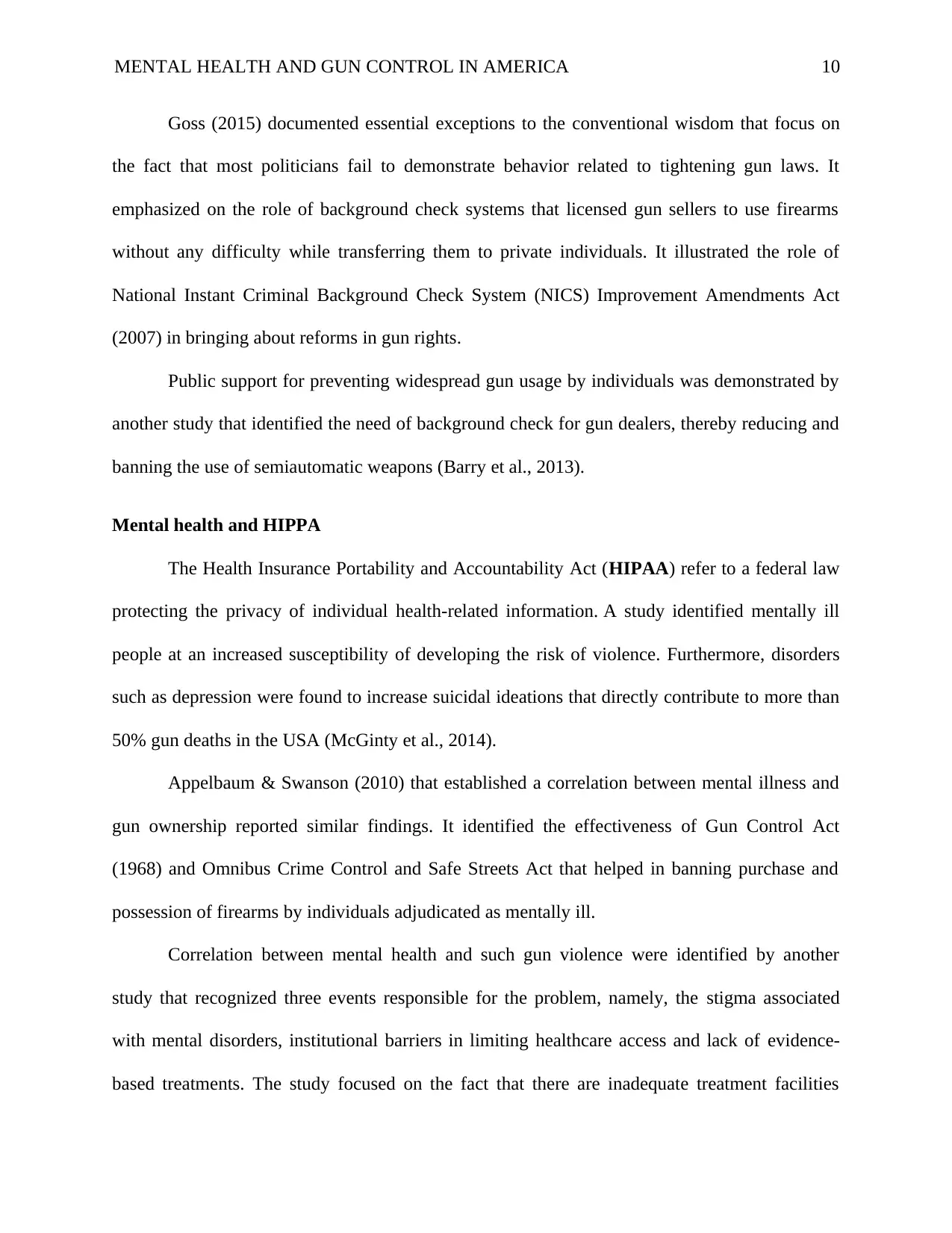
MENTAL HEALTH AND GUN CONTROL IN AMERICA 10
Goss (2015) documented essential exceptions to the conventional wisdom that focus on
the fact that most politicians fail to demonstrate behavior related to tightening gun laws. It
emphasized on the role of background check systems that licensed gun sellers to use firearms
without any difficulty while transferring them to private individuals. It illustrated the role of
National Instant Criminal Background Check System (NICS) Improvement Amendments Act
(2007) in bringing about reforms in gun rights.
Public support for preventing widespread gun usage by individuals was demonstrated by
another study that identified the need of background check for gun dealers, thereby reducing and
banning the use of semiautomatic weapons (Barry et al., 2013).
Mental health and HIPPA
The Health Insurance Portability and Accountability Act (HIPAA) refer to a federal law
protecting the privacy of individual health-related information. A study identified mentally ill
people at an increased susceptibility of developing the risk of violence. Furthermore, disorders
such as depression were found to increase suicidal ideations that directly contribute to more than
50% gun deaths in the USA (McGinty et al., 2014).
Appelbaum & Swanson (2010) that established a correlation between mental illness and
gun ownership reported similar findings. It identified the effectiveness of Gun Control Act
(1968) and Omnibus Crime Control and Safe Streets Act that helped in banning purchase and
possession of firearms by individuals adjudicated as mentally ill.
Correlation between mental health and such gun violence were identified by another
study that recognized three events responsible for the problem, namely, the stigma associated
with mental disorders, institutional barriers in limiting healthcare access and lack of evidence-
based treatments. The study focused on the fact that there are inadequate treatment facilities
Goss (2015) documented essential exceptions to the conventional wisdom that focus on
the fact that most politicians fail to demonstrate behavior related to tightening gun laws. It
emphasized on the role of background check systems that licensed gun sellers to use firearms
without any difficulty while transferring them to private individuals. It illustrated the role of
National Instant Criminal Background Check System (NICS) Improvement Amendments Act
(2007) in bringing about reforms in gun rights.
Public support for preventing widespread gun usage by individuals was demonstrated by
another study that identified the need of background check for gun dealers, thereby reducing and
banning the use of semiautomatic weapons (Barry et al., 2013).
Mental health and HIPPA
The Health Insurance Portability and Accountability Act (HIPAA) refer to a federal law
protecting the privacy of individual health-related information. A study identified mentally ill
people at an increased susceptibility of developing the risk of violence. Furthermore, disorders
such as depression were found to increase suicidal ideations that directly contribute to more than
50% gun deaths in the USA (McGinty et al., 2014).
Appelbaum & Swanson (2010) that established a correlation between mental illness and
gun ownership reported similar findings. It identified the effectiveness of Gun Control Act
(1968) and Omnibus Crime Control and Safe Streets Act that helped in banning purchase and
possession of firearms by individuals adjudicated as mentally ill.
Correlation between mental health and such gun violence were identified by another
study that recognized three events responsible for the problem, namely, the stigma associated
with mental disorders, institutional barriers in limiting healthcare access and lack of evidence-
based treatments. The study focused on the fact that there are inadequate treatment facilities
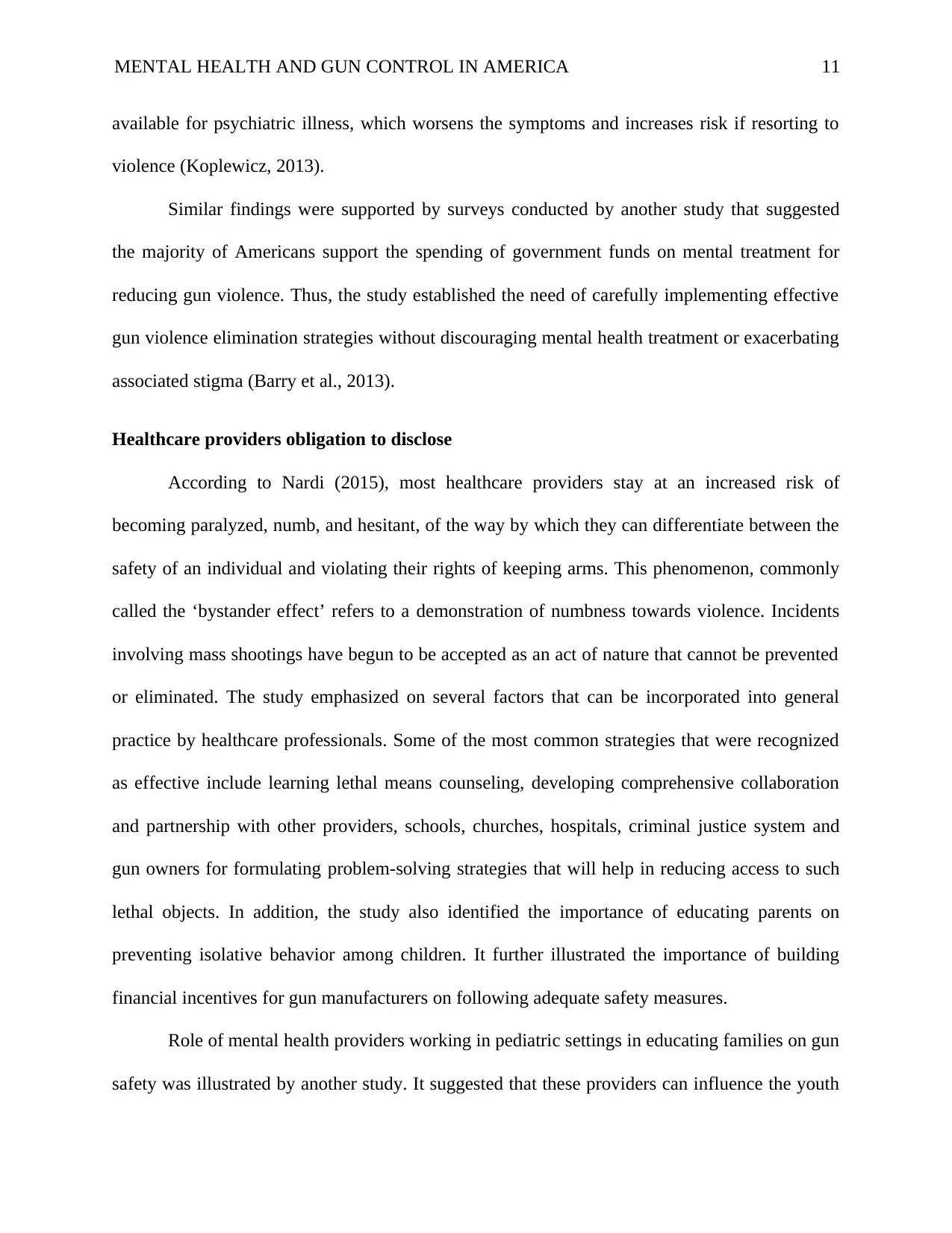
MENTAL HEALTH AND GUN CONTROL IN AMERICA 11
available for psychiatric illness, which worsens the symptoms and increases risk if resorting to
violence (Koplewicz, 2013).
Similar findings were supported by surveys conducted by another study that suggested
the majority of Americans support the spending of government funds on mental treatment for
reducing gun violence. Thus, the study established the need of carefully implementing effective
gun violence elimination strategies without discouraging mental health treatment or exacerbating
associated stigma (Barry et al., 2013).
Healthcare providers obligation to disclose
According to Nardi (2015), most healthcare providers stay at an increased risk of
becoming paralyzed, numb, and hesitant, of the way by which they can differentiate between the
safety of an individual and violating their rights of keeping arms. This phenomenon, commonly
called the ‘bystander effect’ refers to a demonstration of numbness towards violence. Incidents
involving mass shootings have begun to be accepted as an act of nature that cannot be prevented
or eliminated. The study emphasized on several factors that can be incorporated into general
practice by healthcare professionals. Some of the most common strategies that were recognized
as effective include learning lethal means counseling, developing comprehensive collaboration
and partnership with other providers, schools, churches, hospitals, criminal justice system and
gun owners for formulating problem-solving strategies that will help in reducing access to such
lethal objects. In addition, the study also identified the importance of educating parents on
preventing isolative behavior among children. It further illustrated the importance of building
financial incentives for gun manufacturers on following adequate safety measures.
Role of mental health providers working in pediatric settings in educating families on gun
safety was illustrated by another study. It suggested that these providers can influence the youth
available for psychiatric illness, which worsens the symptoms and increases risk if resorting to
violence (Koplewicz, 2013).
Similar findings were supported by surveys conducted by another study that suggested
the majority of Americans support the spending of government funds on mental treatment for
reducing gun violence. Thus, the study established the need of carefully implementing effective
gun violence elimination strategies without discouraging mental health treatment or exacerbating
associated stigma (Barry et al., 2013).
Healthcare providers obligation to disclose
According to Nardi (2015), most healthcare providers stay at an increased risk of
becoming paralyzed, numb, and hesitant, of the way by which they can differentiate between the
safety of an individual and violating their rights of keeping arms. This phenomenon, commonly
called the ‘bystander effect’ refers to a demonstration of numbness towards violence. Incidents
involving mass shootings have begun to be accepted as an act of nature that cannot be prevented
or eliminated. The study emphasized on several factors that can be incorporated into general
practice by healthcare professionals. Some of the most common strategies that were recognized
as effective include learning lethal means counseling, developing comprehensive collaboration
and partnership with other providers, schools, churches, hospitals, criminal justice system and
gun owners for formulating problem-solving strategies that will help in reducing access to such
lethal objects. In addition, the study also identified the importance of educating parents on
preventing isolative behavior among children. It further illustrated the importance of building
financial incentives for gun manufacturers on following adequate safety measures.
Role of mental health providers working in pediatric settings in educating families on gun
safety was illustrated by another study. It suggested that these providers can influence the youth
⊘ This is a preview!⊘
Do you want full access?
Subscribe today to unlock all pages.

Trusted by 1+ million students worldwide
1 out of 30
Related Documents
Your All-in-One AI-Powered Toolkit for Academic Success.
+13062052269
info@desklib.com
Available 24*7 on WhatsApp / Email
![[object Object]](/_next/static/media/star-bottom.7253800d.svg)
Unlock your academic potential
Copyright © 2020–2025 A2Z Services. All Rights Reserved. Developed and managed by ZUCOL.




